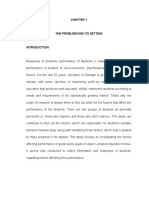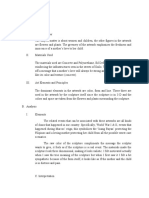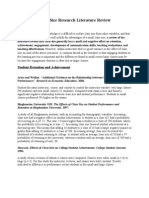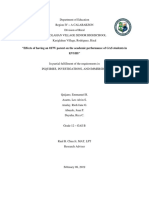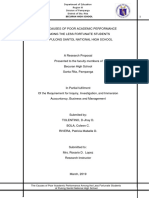Mini Position Paper (REVISED)
Mini Position Paper (REVISED)
Uploaded by
Aiko NakamuraCopyright:
Available Formats
Mini Position Paper (REVISED)
Mini Position Paper (REVISED)
Uploaded by
Aiko NakamuraOriginal Title
Copyright
Available Formats
Share this document
Did you find this document useful?
Is this content inappropriate?
Copyright:
Available Formats
Mini Position Paper (REVISED)
Mini Position Paper (REVISED)
Uploaded by
Aiko NakamuraCopyright:
Available Formats
Aiko Nakamura EDUC 8500/Position Paper 11/18/2012
Cover Note In revising my position paper, I have used my reviewers feedback effectively to make the whole position paper more coherent to revolve the discussion around language learning as a means for communication, and language teaching to promote students communicative competence. On a micro level, for the section of language learning, the reviewer pointed out that my example of Japanese students being incompetent at achieving fluency in English did not relate to the quote cited from a reference, make error work for them and not against them (p. 259) by Brown (2007). I had intended to use the example as a failure story to what the quote says, but had not made that clear, so I changed the wording to make the discussion flow more smoothly. For the section of language teaching, I was advised to separate the concept of students motivation and interest. With this feedback, I realized that I used being interested as being almost equal to being motivated, and hence decided to coherently use the word motivated throughout the paragraph as I did not have enough space to start a discussion as to how they are related to one another. Also, I was suggested to place promoting learner autonomy as one of the components for language learning as the discussion did not sound to be a component for language teaching. However, I had intended to introduce it as an important component in conjunction with experiential learning. Thus, I changed the wordings of the discussion to make it more explicit as to how engaging students in experiential learning and promotion of learner autonomy can correlate, so that it is clearer that the component is important on the teachers side to be included as part of their roles. Finally, as far as APA citation is concerned, I was encouraged to paraphrase more than include direct quotes. Hence, I tried to change some direct quotes to paraphrased sentences. However, I am aware that it still needs some improvement and will keep working on it for the future papers.
Mini Position Paper When discussing what is language learning and language teaching, what must be considered first is, what is language for the learners. Is it only a subject of study in order to pass an exam or get a high score on an assessment test? Or is it a communication tool to be able to exchange opinions, enhance understanding in the people of different cultural and linguistic backgrounds? In other words, what is the learners objective and goal in learning the target language? What and how should a teacher teach a language to students thoroughly depends upon that, and teachers cannot always enforce their philosophy of what a language should be on students. However, as a language leaner who has a strong belief in learning a language as a key and tool to living as an international individual in the wider world, in this position paper, I will set the goal of language learning and language teaching as the following: students learn a language as a means of communication and interaction with the people of global society, and therefore teachers teach a language to promote not only their grammatical competence but also and more importantly their communicative competence. Language Learning Being in an Immersive Environment/Learning in Context I believe that when learning a language, it is important that one is in an immersive environment where the target language is actually used in a real life context. However, an immersive environment does not necessarily have to be that one is in a country where it is spoken locally though it is undoubtedly preferred if such an opportunity exists, but it is that one has the access to people whose mother tongue is the target language or simply to various authentic materials in which the language is used so that one is able to practice speaking in a context and listening to the natural dialogues. What this leads to is the enhancement of confidence and motivation in actually using what they learned in class outside the class, which I believe is the most important in acquiring a language. If anything that was learned in class only maintains in the realm of studying, the language remains to be a subject of study and not a tool to communicate. As Brown (2007) maintains, successful language learners generally believe in themselves and in their capacity to accomplish communicative tasks, and are therefore willing risk takers in their attempts to produce and to interpret language that is a bit beyond their absolute certainty (p. 73). The creation of immersive environment in classroom should give students the willingness to communicate, 2
which links to building ones self-confidence, which then allows oneself to take risks to make mistakes, which in the end allows further improvement in ones skill. As I was a language learner for Spanish in Japan, the teacher mainly taught us grammar in class following a textbook. He went through it explaining the grammar, and made us do the problems on the textbook and share the answers in the class. That was the whole routine of the course, and the students were seldom fully engaged in the class, unmotivated to participate. The teacher usually started in Spanish to talk to us but switched immediately to English as he saw the students not understanding him. Despite him explaining in English, most students were not following the class, and were not grasping the grammar. As I was a passionate learner myself at that time intrinsically motivated to acquire the language, I committed in studying the textbook, and in addition created myself an environment where I could expose myself to listening to the real Spanish conversation and speaking it in a context by getting apart time job at a Spanish bar where there were Latin American workers. Being in such an immersive environment where I could try using what I learned in class enhanced my study on grammar in class. As Savignon (2005) indicates that learners seem to focus best on grammar when it relates to their communicative needs and experiences, it is effective to let students see the target language being used in a real situation. To support this idea in a classroom, I would incorporate a theme-based instruction. If it were a grammar class, students would read articles of the set theme such as election or world economics, and examine how the grammar points are used. They would also give opinions regarding the article by using what they just learned. This way, students are not only learning the forms of the target language, but experiencing how the forms can be used in a context, which should be more stimulating and easier to absorb judged from my own experience. Kumaravadivelu (2003) also supports this idea that using language for effective communication integrates contextual factors, and, there, teaching it for effective learning must invoke contextualization of linguistic input (p. 213). Willing to Making Mistakes Another significant component for language learning is to not hesitate to make mistakes, in other words, to be willing to make mistakes. As a language learner, I have struggled enormously lacking this component. Being unable to take risks to make mistakes signifies missing out on the great opportunities 3
to practice using the target language. By being willing to make mistakes and making them into learning opportunities, one is able to improve language skill especially in terms of fluency, or communicative competence in the target language. Hence, to be a successful language learner, one must be willing to make mistakes. Looking at typical Japanese learners is a good example that demonstrates how lacking this component could have a negative effect in improving ones language. Even among the Asians, Japanese in particular are said to be incompetent at speaking English. I believe it is commonly seen by most ESL teachers who have taught Japanese students that they do not try tot talk in class, which makes them unable to achieve certain fluency when communicating in English. I believe that such a trend arises from the traditional form of instruction for teaching English in Japan, which puts an emphasis on grammar, and which allows only one right answer to all questions. Consequently, Japanese have tended to be very careful and sensitive to what is grammatically correct or not, which hinder them from pursuing speaking the language with fluency. In terms of writing and reading skill, such a stance of pursuing accuracy when learning a language may be effective. However, when acquiring a language to be able to communicate and exchange opinions with others, that is, to promote communicative competence, one must not be too cautious in making mistakes. Brown (2007) also mentions as a component for good language learners, to make error work for them and not against them (p. 259) as an important element to promote communicative competence in the target language. To support this, a teacher must not correct every mistake students make in class but make sure that they have chances to pursue fluency in English without paying too much attention to speaking without mistakes (Brown, 2007, p. 80). Hence, in the classroom, I would create opportunities where students can casually speak out. To do so, I believe it is important that students realize that the focus is not put on accuracy in the lesson but on being able to convey ones idea to others. In achieving this, the activities such as debates and simply various group activities should be effective in having students to focus on achieving a goal by using the language, rather than for improving the language. Above all, I believe that to support students in making mistakes, it is mostly dependent upon a teachers behavior whether s/he can provide the kind of warm embracing climate that encourages students to speak, however halting or broken their attempts may be (Brown, 2007, p. 324). 4
Language Teaching Keeping Students Intrinsically Motivated One of the most important components for language teaching in the classroom is keeping students motivated. I believe it is largely dependent upon the teacher as to how students would perceive how learning a language is; that is, whether it is beneficial, interesting, important, or simply fun or not. We all have an experience that one subject was very boring in one place but turned out to be quite interesting in another just because of the different ways of teaching in the classroom, and began to be motivated to learn the subject. It is the same with learning a language for students. The ways of instruction matter significantly to how much students become motivated to learn a language. As Gardner (1985) says, motivation refers to the effort, want (desire), and affect associated with learning a second language is seen as important in determining how actively the individual works to acquire language material (p. 147). When I say motivation, I mean intrinsic motivation. From my experience, extrinsic motivation works only for short time of period to retain what was learned in class. A good example is that currently, I can say that I do not retain a lot about the subjects I learned in high school or college that I studied only because they were required for graduating. On the other hand, the studies I completed with enthusiasm and high motivation because I was interested in the content have still been retained in my brain. Brown (2007) also supports this saying that for long-term retention, the major research on motivation strongly supports intrinsic drives (p. 89). Not only do I not wish my future students to be learning in my class only so that they can fulfill their requirement, I wish them to see the classroom as an opportunity to gain skills useful for their future. That is, acquiring the language skills to broaden their perspective, to be able to exchange and share opinions with different others, to enhance cultural understandings, and to develop themselves as an international figure. In order to achieve the enhancement of intrinsic motivation in the classroom, I would have students to come up with the objectives and goals in learning the language on their own individually at the beginning of class so that they can be conscious as to how the learning a language can relate to their life other than taking it as a mere subject in school. As Brown (2007) indicates, teacher can also present classroom activities in a way that are appealing to learners self-determination and autonomy (p. 92) accommodating to individual needs. For example, if a student likes to practice speaking but is reluctant in 5
writing, a teacher could let s/he recognize how writing entails a thinking process that is useful in giving opinions or making a speech. If such an individual approach is difficult in the beginning of a course, a teacher can always try to include topics that are stimulating particularly to the learners of the same background and age in general, and introduce the lessons in relation to their personal life. For instance, if the students are all from the same country, a teacher can throw a theme such as tourism and ask students to think how much English is pervaded in the country to reinforce tourism; where they see signs in English, which place or part still needs improvement, etc. In this way, students are able to reflect on their daily lives, and see English used in society as a means and not an end, which has a potential of drawing out intrinsic motivation of the students towards the language. Engaging Students in Experiential Learning and Promoting Learner Autonomy Effective language teaching to enhance students language learning as a means of communication should involve students in experiential activities, and promote their autonomy in class. Although what is an effective learning strategy depends on individuals, as far as acquiring a language to enhance communicative competence is concerned, I believe that the classroom should be student-centered in which students can engage in hands-on activities to implement what they learned as concepts or rules. According to Brown (2007), this is called an experiential learning, which includes activities that engage both left- and right-brain processing, that contextualize language, that integrate skills, and that point toward authentic, real-world purposes (p. 291). What this promotes is the aforementioned intrinsic motivation as it lets students to engage in activities or projects in which they have to reflect on their own experiences and ideas. In this way, students are able to gain a deeper understanding of what is being taught. In conjunction with this, I believe that a teacher should promote learner autonomy. If a learner does not know how to learn a language outside of classroom as well, from their experience of the world, their language learning is restricted to the experience in classroom, which I believe does not allow one to achieve communicative competence in the language. As Brown (2007) claims, successful mastery of a foreign language will depend to a great extent on learners autonomous ability both to take initiative in the classroom and to continue their journey to success beyond the classroom and the teacher (p. 70). In Japan, students are often passive learners in class owing to the cultural norm for a classroom that a teacher gives a lecture and students listen. The only time the students actually give outputs from 6
what they learn in class is when they fill in the blanks of the sentences, which are directly taken out of the textbook. Basically, the students only need to memorize the sentences. Although such a trend may be disappearing now in Japan very gradually influenced by an international viewpoint to what and how language learning should be, I myself have received an education on English this way, and I must say it was only effective in passing exams, and ineffective in having myself acquire the language beyond the classroom in relation to the outside world, and hence it remained as one of the mere subjects to study at school. It was when I started studying for TOEFL test that I was able to feel the sense of actually acquiring the language as a means for communication for the first time. Preparation for the test, which assesses learners ability to use English in the real life context to, allowed me to use what I learned in school to be applied to actually writing an essay to give my own opinion, and to reading and comprehending the points by myself from a authentic reading material. Since then, I have been able to perceive English as a tool for communication, and study the language on my own through various articles online, newspapers, etc, which has definitely contributed to improving my communicative competence in English. Benson (2001) indicates that the successful learner is now increasingly seen as someone who is capable of constructing knowledge directly from experience of the world, rather than one who is able to respond well to instruction (p. 19), teachers should encourage students to engage in activities and projects in class that requires them to go beyond the classrooms to deal with the target language, and promote their autonomy in facing the language in their real world. To engage students in experiential learning and promote their learner autonomy, I would provide various projects and activities in which the students can reflect on their own experience and engage in preparation outside the class such as role-plays and research projects. Teacher can give basic instructions on what needs to be included and shared with class as a final product but how to organize these activities in each group can be student-led so that they are open to creativity and are autonomously working. Promoting a sense of autonomy in the students in this way should also help them gain a sense of confidence after a project is over that they were able to complete something in the target language on their own, and the understanding that learning the language has actually allowed them to see a wider authentic world. I believe that they are very crucial in having students acquire a target language as a means of communication. 7
References Benson, P. (2001). Teaching and researching: autonomy in language learning. Harlow: Pearson Education Limited Brown, H.D. (2007). Teaching by principles: An interactive approach to language pedagogy (3rd ed). Harlow, England: Longman/Pearson ESL. Gardner, R.C. (1985). Social psychology and second language learning. Maryland: Edward Arnold Ltd. Kumaravadivelu, B. (2003). Beyond methods: Macrostrategies for language teaching. New Haven: Yale University Press. Savignon, S. (2005). Communicative Language Teaching: Strategies and Goals. New Jersey: Lawrence Erlbaum Associates, Inc.
You might also like
- DLL 1 Intro To Personal DevelopmentDocument4 pagesDLL 1 Intro To Personal Developmentanon_298904132100% (17)
- Narrative Report On Brigada Eskwela S.Y 2021-2022Document5 pagesNarrative Report On Brigada Eskwela S.Y 2021-2022Richie Macasarte100% (2)
- Willingham Mtssrtipbis Se315 Sum23Document17 pagesWillingham Mtssrtipbis Se315 Sum23Kaylee WillinghamNo ratings yet
- Nqesh Reviewer HandbookDocument78 pagesNqesh Reviewer Handbookrandolf traigo100% (15)
- Corporate Profile WFG 2020-UpdatedDocument22 pagesCorporate Profile WFG 2020-UpdatedMofoluso AribisalaNo ratings yet
- Lesson Plan Triple JumpDocument5 pagesLesson Plan Triple Jumpapi-264509853No ratings yet
- Review of Related Literature This Chapter Presents A Summary of Readings On Related Literature and RelatedDocument3 pagesReview of Related Literature This Chapter Presents A Summary of Readings On Related Literature and Relatedmechell mativoNo ratings yet
- Abm Senior High School StudentsDocument19 pagesAbm Senior High School StudentsShekinah BaguhinNo ratings yet
- Updated PR2Document32 pagesUpdated PR2Lawrence ZowwNo ratings yet
- A Correlational Study On The Level of Academic Stress. Samson JDocument36 pagesA Correlational Study On The Level of Academic Stress. Samson Jjanphilmar20No ratings yet
- Coping-Mechanism-Of-Grade-10-Students - Edited June 04Document5 pagesCoping-Mechanism-Of-Grade-10-Students - Edited June 04Wenslee AloneNo ratings yet
- Effect of Financial Status: Things That Influence The Students in Choosing A Course For CollegeDocument26 pagesEffect of Financial Status: Things That Influence The Students in Choosing A Course For CollegeVanjo MuñozNo ratings yet
- RRL NewDocument6 pagesRRL NewCris Alvin De Guzman0% (1)
- University of Caloocan City HistoryDocument8 pagesUniversity of Caloocan City HistoryClark Raj Ledesma VbNo ratings yet
- Study Habits and Devoted To StudyingDocument21 pagesStudy Habits and Devoted To StudyingMarvin PañaNo ratings yet
- Factors Affecting in Blended Learning On The Academic Performance of Grade34 1Document28 pagesFactors Affecting in Blended Learning On The Academic Performance of Grade34 1Marchee AlolodNo ratings yet
- The Effect of Time Schedule On The Students'Document32 pagesThe Effect of Time Schedule On The Students'Andrea Celina DinglasanNo ratings yet
- The Factors That Affects A Grade 11 GAS StudentDocument12 pagesThe Factors That Affects A Grade 11 GAS StudentNicole R. IlaganNo ratings yet
- Level of Difficulties Encountered by Grade 11 Senior High School Students in General Mathematics S.Y 2020-2021Document17 pagesLevel of Difficulties Encountered by Grade 11 Senior High School Students in General Mathematics S.Y 2020-2021Cristina MirallesNo ratings yet
- Impact of Using Facebook Towards Grade 12 Abm Students' Self-EsteemDocument5 pagesImpact of Using Facebook Towards Grade 12 Abm Students' Self-EsteemMa. Kristine Laurice AmancioNo ratings yet
- Impact of PowerPoint Presentation On The Academic Performance of Students 1Document11 pagesImpact of PowerPoint Presentation On The Academic Performance of Students 1Dannielle Daphne GasicNo ratings yet
- Chapter I The Problem and The Review of LiteratureDocument4 pagesChapter I The Problem and The Review of LiteratureYu KandaNo ratings yet
- PR 2 Week 6Document23 pagesPR 2 Week 6JoshNo ratings yet
- Research About Early ClassesDocument85 pagesResearch About Early ClassesPatricia Belle LorenzoNo ratings yet
- The Effectiveness of Implementing Shortened Period Class HoursDocument38 pagesThe Effectiveness of Implementing Shortened Period Class HoursmikecagataNo ratings yet
- A Research Study On How Financial Problem Affects The Self - Esteem of Grade 12 Student in Titay National High SchoolDocument3 pagesA Research Study On How Financial Problem Affects The Self - Esteem of Grade 12 Student in Titay National High SchoolMagnus AidenNo ratings yet
- The Implication of Learning Strategy and Learning Beliefs of Gas Student Academic PerformanceDocument2 pagesThe Implication of Learning Strategy and Learning Beliefs of Gas Student Academic PerformanceKrizanne Grace Denosta0% (1)
- RRL Academic PerformanceDocument1 pageRRL Academic Performancewicc csNo ratings yet
- Article CritiqueDocument2 pagesArticle CritiqueAlexandra SofiaNo ratings yet
- Chapter IDocument5 pagesChapter IESTERNINOSNo ratings yet
- Chapter 1 SOPDocument15 pagesChapter 1 SOPJassien Moring FlorentinoNo ratings yet
- Problems Encountered by Abm Students in Business Finance 1Document8 pagesProblems Encountered by Abm Students in Business Finance 1Joram David Beltran100% (1)
- Mount Carmel College Baler, Aurora Integrated Basic Education Department Senior High School Level S.Y. 2019-2020 AcknowledgmentDocument5 pagesMount Carmel College Baler, Aurora Integrated Basic Education Department Senior High School Level S.Y. 2019-2020 AcknowledgmentReabels FranciscoNo ratings yet
- Class Participation and Student PerformanceDocument15 pagesClass Participation and Student PerformanceRoderick Viloria MiloNo ratings yet
- Chapter 1 To 3 Level of Leadership SkillsDocument19 pagesChapter 1 To 3 Level of Leadership SkillsSheiryl Isabelo GomezNo ratings yet
- Chapter 1 - Introduction RationaleDocument16 pagesChapter 1 - Introduction RationaleTaurus SilverNo ratings yet
- Difficulties Encountered by The StudentsDocument30 pagesDifficulties Encountered by The Studentsisaac e ochigboNo ratings yet
- A Quantitative Research Presented To The Faculty of Bicol College Inc. Senior High School Department Daraga, AlbayDocument32 pagesA Quantitative Research Presented To The Faculty of Bicol College Inc. Senior High School Department Daraga, AlbaylabradorjustinbrentNo ratings yet
- P ResearchDocument14 pagesP ResearchBab SitaNo ratings yet
- Final Research PaperDocument22 pagesFinal Research PaperMarietoni PallanNo ratings yet
- Chapter 1Document7 pagesChapter 1CJNo ratings yet
- Chapter 1-3Document28 pagesChapter 1-3Oral RobertNo ratings yet
- Self-Efficacy and Learning Outcomes Among The College of Teacher Education Working Students of The University of MindanaoDocument11 pagesSelf-Efficacy and Learning Outcomes Among The College of Teacher Education Working Students of The University of MindanaoAnthon Bautista0% (1)
- Assessment of The Academic Performance of 4p's Pupils Beneficiaries of Sultan Ali Dimaporo Integrated School: Basis For Remediation ProgramDocument9 pagesAssessment of The Academic Performance of 4p's Pupils Beneficiaries of Sultan Ali Dimaporo Integrated School: Basis For Remediation ProgramPsychology and Education: A Multidisciplinary JournalNo ratings yet
- Influence of Social Pressures On The Academic Performance of HUMSS Students at NU-NazarethDocument31 pagesInfluence of Social Pressures On The Academic Performance of HUMSS Students at NU-Nazarethbobbyescalante16No ratings yet
- To Thine Own Self Be True 1st PrizeDocument5 pagesTo Thine Own Self Be True 1st PrizeRilanne AcostaNo ratings yet
- Art Analysis-IncompleteDocument3 pagesArt Analysis-IncompletellxnesNo ratings yet
- Chapter I VDocument36 pagesChapter I VJoana Marie SaperaNo ratings yet
- Document 2 - Parts of Chapter 2 SamplesDocument11 pagesDocument 2 - Parts of Chapter 2 SamplesKreshia Kyrelle BundalNo ratings yet
- FL FS LL LS Nico EscullarDocument10 pagesFL FS LL LS Nico EscullarKiela Aika IshimuraNo ratings yet
- What I Know: Creative Nonfiction Week 9Document9 pagesWhat I Know: Creative Nonfiction Week 9Aldrain MallariNo ratings yet
- Academic Text Reading Skills of Senior High School Students of Batangas CityDocument9 pagesAcademic Text Reading Skills of Senior High School Students of Batangas CityElkissa Joy Lumbres Yutuc100% (1)
- CHAPTER 2 Tvl-HeDocument3 pagesCHAPTER 2 Tvl-HeNicolette Dayrit Dela PenaNo ratings yet
- Class Size Research Literature ReviewDocument5 pagesClass Size Research Literature ReviewAirah ApoyaNo ratings yet
- Maranatha Christian Academy of Caloocan 1594 Jasmin ST., Area A Camarin, Caloocan CityDocument3 pagesMaranatha Christian Academy of Caloocan 1594 Jasmin ST., Area A Camarin, Caloocan CityJes NapiñasNo ratings yet
- Chapter 2Document6 pagesChapter 2dv vargasNo ratings yet
- Modular Distance Learning Modality in Relation To Students' Learning During Covid-19Document3 pagesModular Distance Learning Modality in Relation To Students' Learning During Covid-19Angeline CaraleNo ratings yet
- The K To 12 Program Covers Kindergarten and 12 Years of Basic EducationDocument3 pagesThe K To 12 Program Covers Kindergarten and 12 Years of Basic EducationJohn AxelNo ratings yet
- A Study On The Perception of The Grade 12 Students of Saint Mary's University Senior High School On Experiencing Communication Barriers During Distance EducationDocument18 pagesA Study On The Perception of The Grade 12 Students of Saint Mary's University Senior High School On Experiencing Communication Barriers During Distance EducationPsychology and Education: A Multidisciplinary JournalNo ratings yet
- Rioh AutosavedDocument14 pagesRioh AutosavedCJ Timuat RoldanNo ratings yet
- CHAPTER2ELLADocument4 pagesCHAPTER2ELLAmark reyesNo ratings yet
- Questionnaire and ObjectivesDocument4 pagesQuestionnaire and ObjectivesRoshia Mayores BelloNo ratings yet
- THE CAUSES OF POOR ACADEMIC PERFORMANCExxDocument26 pagesTHE CAUSES OF POOR ACADEMIC PERFORMANCExxgabriela delacuestaNo ratings yet
- PR2 Population and SamplingDocument14 pagesPR2 Population and SamplingMary Joy Llosa RedullaNo ratings yet
- AttitudeICT QuestionnaireDocument1 pageAttitudeICT QuestionnaireVincent WilburNo ratings yet
- Transitions to K–12 Education Systems: Experiences from Five Case CountriesFrom EverandTransitions to K–12 Education Systems: Experiences from Five Case CountriesRating: 4 out of 5 stars4/5 (2)
- (Edited) 2014 FL Symposium Call For ProposalsDocument3 pages(Edited) 2014 FL Symposium Call For ProposalsAiko NakamuraNo ratings yet
- Cover Note: Takako Kobayashi and Aiko Nakamura EDUC 8500/ Lesson Plan UnitDocument22 pagesCover Note: Takako Kobayashi and Aiko Nakamura EDUC 8500/ Lesson Plan UnitAiko NakamuraNo ratings yet
- Variation Project Paper (Final)Document18 pagesVariation Project Paper (Final)Aiko NakamuraNo ratings yet
- Resume:Aiko NakamuraDocument2 pagesResume:Aiko NakamuraAiko NakamuraNo ratings yet
- Early Childhood Research Quarterly: Lia E. Sandilos, Priscilla Goble, Sara E. Rimm-Kaufman, Robert C. PiantaDocument11 pagesEarly Childhood Research Quarterly: Lia E. Sandilos, Priscilla Goble, Sara E. Rimm-Kaufman, Robert C. PiantaPetrutaNo ratings yet
- Robla School District Calendars 2013-14Document2 pagesRobla School District Calendars 2013-14NorthSacBeatNo ratings yet
- Legal Translation Jordan UniDocument3 pagesLegal Translation Jordan UniAsma R. El KawafiNo ratings yet
- Preamble: Admission CriteriaDocument2 pagesPreamble: Admission CriteriaSANKHANWAR14_2197021No ratings yet
- Q2 WS TLE 7 Lesson 8 Week 6Document5 pagesQ2 WS TLE 7 Lesson 8 Week 6Leonor CorpuzNo ratings yet
- Penerapan Model Discovery Learning Untuk Meningkatkan Keterampilan Generik Sains SiswaDocument11 pagesPenerapan Model Discovery Learning Untuk Meningkatkan Keterampilan Generik Sains SiswaSitihajarNo ratings yet
- TCHE2402 2016 Method 2 Study Course Guide (21!2!16)Document10 pagesTCHE2402 2016 Method 2 Study Course Guide (21!2!16)felfelrocksNo ratings yet
- New Text DocumentDocument2 pagesNew Text Documentzubairenterprises68No ratings yet
- Stronger - Clearer Strategy Reference SheetDocument3 pagesStronger - Clearer Strategy Reference SheetEsmeralda CartagenaNo ratings yet
- Educational Administration in Pakistan: Unit-5Document21 pagesEducational Administration in Pakistan: Unit-5Rabia qadirNo ratings yet
- 3320602Document9 pages3320602Ravi Teja TNo ratings yet
- Maedf4 204 Reflective Journal No. 3Document3 pagesMaedf4 204 Reflective Journal No. 3Eddiely OlvidoNo ratings yet
- ISTE Form Life MemberDocument5 pagesISTE Form Life MemberAshok KumarNo ratings yet
- Public Spanish 2 Course Map - Spanish 2Document2 pagesPublic Spanish 2 Course Map - Spanish 2api-534094065No ratings yet
- The Teacher in The 21st Century SocietyDocument5 pagesThe Teacher in The 21st Century SocietyRose Ann Sanao100% (1)
- NSTP LTS Activity 1 30 PointsDocument2 pagesNSTP LTS Activity 1 30 PointsFrela PauloNo ratings yet
- Sarah Mills ResumeDocument2 pagesSarah Mills Resumeapi-264539530No ratings yet
- Summer Onc Fellowship (SORF) Flyer 2019-10-18 PDFDocument1 pageSummer Onc Fellowship (SORF) Flyer 2019-10-18 PDFPiyushNo ratings yet
- Seven Days National FDP On Research MethodologyDocument13 pagesSeven Days National FDP On Research MethodologyresearcherforceNo ratings yet
- The Rewards of LearningDocument11 pagesThe Rewards of LearningalinaNo ratings yet
- Newsletter - September 2023Document7 pagesNewsletter - September 2023api-688138541No ratings yet
- Ireland Fellows Programme - Stage 1 Guidance Note and Application FormDocument16 pagesIreland Fellows Programme - Stage 1 Guidance Note and Application Form祝福No ratings yet
- Analyzing Visual Elements: Learning ObjectivesDocument4 pagesAnalyzing Visual Elements: Learning ObjectivesGine FrencilloNo ratings yet
- Narrative Report On Educational TourDocument6 pagesNarrative Report On Educational TourBeilijical Sarce Mkkns63% (8)









































